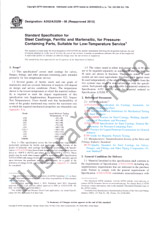Potřebujeme váš souhlas k využití jednotlivých dat, aby se vám mimo jiné mohly ukazovat informace týkající se vašich zájmů. Souhlas udělíte kliknutím na tlačítko „OK“.
ASTM E307-72(2019)
Standard Test Method for Normal Spectral Emittance at Elevated Temperatures
Přeložit název
NORMA vydána dne 1.10.2019
Informace o normě:
Označení normy: ASTM E307-72(2019)
Datum vydání normy: 1.10.2019
Kód zboží: NS-972593
Počet stran: 6
Přibližná hmotnost: 18 g (0.04 liber)
Země: Americká technická norma
Kategorie: Technické normy ASTM
Kategorie - podobné normy:
Anotace textu normy ASTM E307-72(2019) :
Keywords:
emittance, infrared emittance, material radiative property, radiative heat transfer, spacecraft thermal control, spectral normal emittance, thermal radiation,, ICS Number Code 71.040.50 (Physicochemical methods of analysis)
Doplňující informace
| Significance and Use | ||
|
5.1 The significant features are typified by a discussion of the limitations of the technique. With the description and arrangement given in the following portions of this test method, the instrument will record directly the normal spectral emittance of a specimen. However, the following conditions must be met within acceptable tolerance: 5.1.1 The effective temperatures of the specimen and blackbody must be within 1 K of each other. Practical limitations arise, however, because the temperature uniformities are often not better than a few degrees Kelvin. 5.1.2 The optical path length in the two beams must be equal, or the instrument should operate in a nonabsorbing atmosphere or a vacuum, in order to eliminate the effects of differential atmospheric absorption in the two beams. Measurements in air are in many cases important, and will not necessarily give the same results as in a vacuum, thus the equality of the optical paths for dual beam instruments becomes very critical. Note 3: Very careful optical alignment of the
spectrophotometer is required to minimize differences in
absorptance along the two paths of the instrument, and careful
adjustment of the chopper timing to reduce “cross-talk” (the
overlap of the reference and sample signals) as well as precautions
to reduce stray radiation in the spectrometer are required to keep
the zero line flat. With the best adjustment, the “100 % line” will
be flat to within 3 %; both of these measurements should be
reproducible within these limits (see 7.3, Note
6).
5.1.3 Front-surface mirror optics must be used throughout, except for the prism in prism monochromators and the grating in grating monochromators, and it should be emphasized that equivalent optical elements must be used in the two beams in order to reduce and balance attenuation of the beams by absorption in the optical elements. It is recommended that optical surfaces be free of SiO5.1.4 The source and field apertures of the two beams must be equal in order to ensure that radiant flux in the two beams compared by the apparatus will pertain to equal areas of the sources and equal solid angles of emission. In some cases it may be desirable to define the solid angle of the source and sample when comparing alternative measurement techniques. 5.1.5 The response of the detector-amplifier system must vary linearly with the incident radiant flux. |
||
| 1. Scope | ||
|
1.1 This test method describes a highly accurate technique for measuring the normal spectral emittance of electrically conducting materials or materials with electrically conducting substrates, in the temperature range from 600 to 1400 K, and at wavelengths from 1 to 35 μm. 1.2 The test method requires expensive equipment and rather elaborate precautions, but produces data that are accurate to within a few percent. It is suitable for research laboratories where the highest precision and accuracy are desired, but is not recommended for routine production or acceptance testing. However, because of its high accuracy this test method can be used as a referee method to be applied to production and acceptance testing in cases of dispute. 1.3 The values stated in SI units are to be regarded as the standard. The values in parentheses are for information only. 1.4 This standard does not purport to address all of the safety concerns, if any, associated with its use. It is the responsibility of the user of this standard to establish appropriate safety, health, and environmental practices and determine the applicability of regulatory limitations prior to use. 1.5 This international standard was developed in accordance with internationally recognized principles on standardization established in the Decision on Principles for the Development of International Standards, Guides and Recommendations issued by the World Trade Organization Technical Barriers to Trade (TBT) Committee. |
||
| 2. Referenced Documents | ||
|
Odebírejte informace o nově vydaných normách ZDARMA:
Chcete pravidelně odebírat informace o nově vycházejících normách z celého světa a to zcela zdarma?
Přihlašte se k odběru. Vše je velice jednoduché a absolutně ZDARMA.
Na výběr máte vydavatele z celého světa.




 Cookies
Cookies
